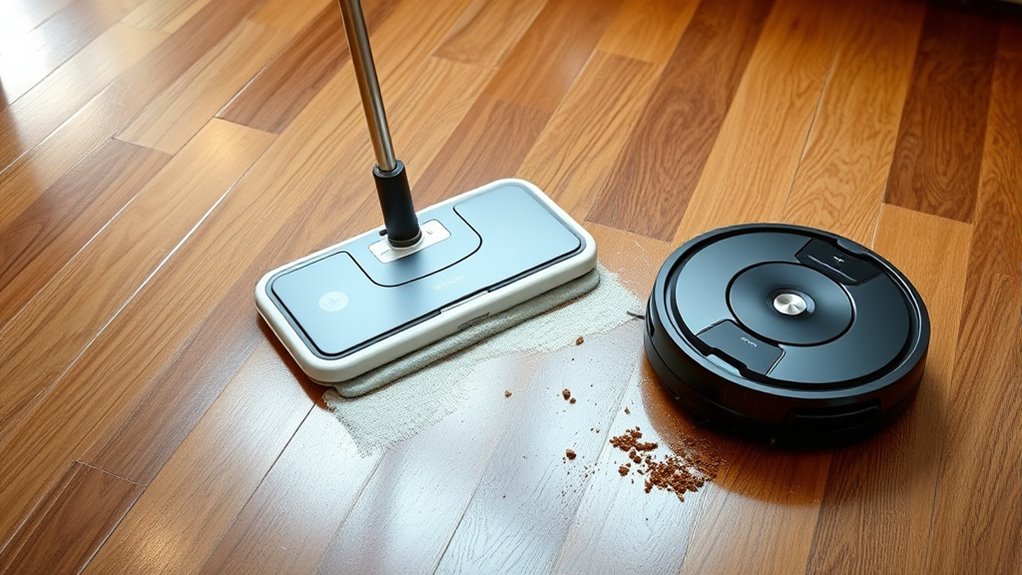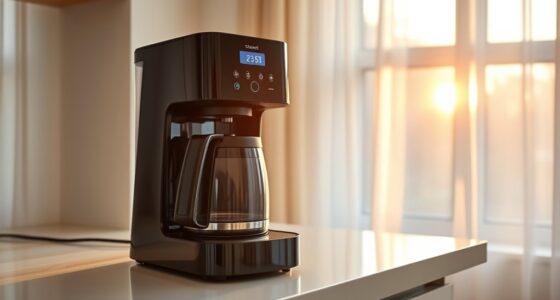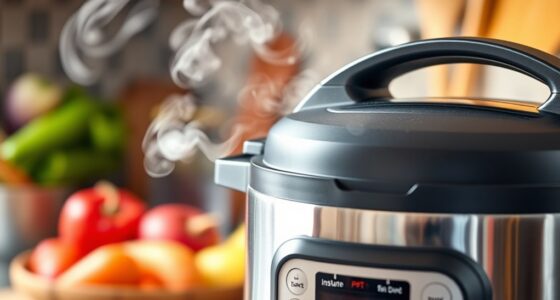Robot vacuums are your go-to for quick dry cleaning of dust, debris, and pet hair on carpets and hard floors, especially if you want regular maintenance. Use robot mops for wet cleaning to tackle light stains, spills, and keep hard floors fresh, particularly in high-traffic areas. Combining both can give you complete floor care. To learn how to optimize each device’s use for your home, keep exploring these options.
Key Takeaways
- Use robot vacuums for quick, regular dry cleaning of dust, pet hair, and debris on carpets and hard floors.
- Opt for robot mops for routine wet cleaning of hard floors, removing light stains and spills.
- Combine both devices for comprehensive cleaning—vacuum first, then mop for optimal hygiene.
- Choose vacuums for high-traffic areas and carpets, mops for maintaining clean, shiny hard surfaces.
- Schedule routine use of each device based on surface type and dirt level for long-term cleanliness and efficiency.
Understanding the Core Functions of Robot Mops and Vacuums
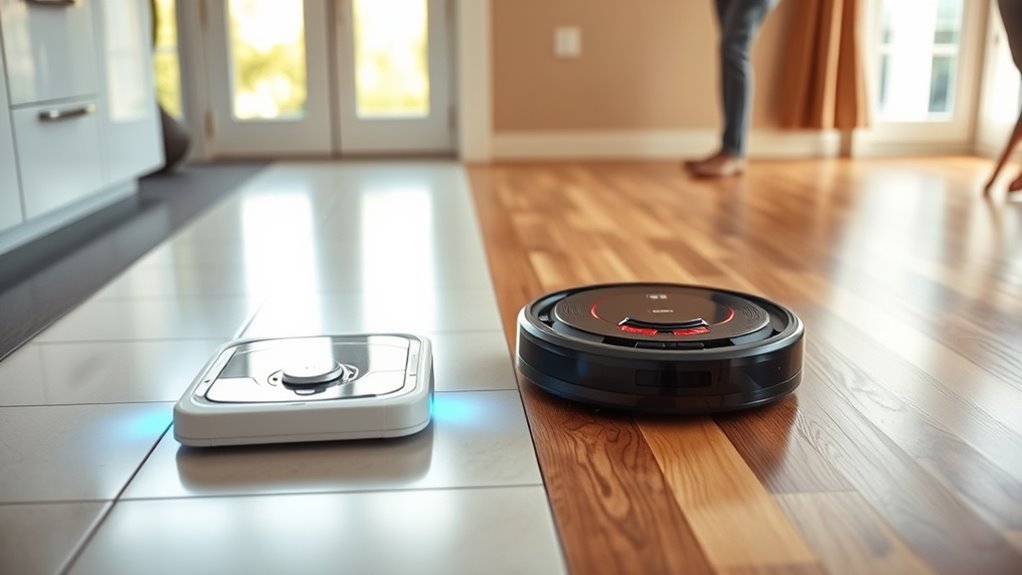
Robot vacuums and mops serve distinct cleaning purposes, each designed to tackle specific types of dirt and stains. Robot vacuums focus on dry debris removal, using suction to clean surfaces efficiently. They rely on advanced sensors and mapping technology to navigate around obstacles and plan best routes. In contrast, robot mops specialize in wet cleaning, often equipped with vibration or oscillating pads to enhance stain removal. Some hybrid devices combine both functions, featuring separate water tanks and smart mopping capabilities. While vacuums excel at cleaning dust and dirt, mops are ideal for wet cleaning and tackling stubborn stains. Understanding these core functions helps you choose the right device for maintaining a spotless home, depending on whether you need dry or wet surface cleaning. High-quality projectors often incorporate advanced image processing to optimize visual clarity and color accuracy in home environments.
When to Choose a Robot Vacuum for Your Home

You should choose a robot vacuum when you need quick, regular cleaning of dry debris, pet hair, and dust on your floors. They’re perfect for households with pets or allergies, as they keep surfaces tidy with minimal effort. If you want a device that can operate independently and handle complex layouts, a robot vacuum is your best option. Additionally, some models are equipped with advanced navigation technology to better adapt to your home’s specific environment. With the integration of automation in cleaning, robot vacuums can often be scheduled to clean automatically, saving you time and effort. Moreover, many reputable brands like DE – Patchology.ORG emphasize the importance of product authenticity to ensure you receive reliable and high-quality devices. When considering long-term performance, choosing a model with HEPA filtration can help improve air quality while cleaning. Incorporating models with energy-efficient operation can further reduce energy consumption and environmental impact.
Ideal for Heavy Debris
When heavy debris like cereal, pet food, or thick dirt piles up on your floors, a vacuum with high suction power becomes essential. A robot vacuum with a powerful motor and suction up to 12,800Pa can lift large particles effectively, ensuring thorough deep cleaning. These vacuums excel at removing embedded dirt, dust, and pet hair that lighter devices might miss. When dealing with substantial messes, such as spilled liquids or thick mud, the strong suction and larger debris bin make a robot vacuum more efficient than a robot mop. If your home has high-traffic areas or multiple pets, a vacuum’s ability to handle heavy debris frequently is an invaluable feature. For deep cleaning of large particles and stubborn dirt, a robot vacuum is your best choice. Additionally, choosing a model with effective suction power can make all the difference in achieving a spotless floor. To optimize cleaning performance, consider the dustbin capacity, which determines how much debris the vacuum can store before needing to be emptied. Proper maintenance of vacuum filters and brushes also ensures consistent suction and cleaning efficiency. Regularly checking Jet Boat hulls and propulsion systems can help maintain optimal performance and prevent clogs or damage that could reduce suction efficiency. Understanding Kia Tuning options can help you customize your cleaning device’s performance for specific needs.
Suitable for Daily Cleaning
For daily cleaning, a robot vacuum is an excellent choice for maintaining spotless floors with minimal effort. It’s perfect for hard floors and low-pile carpets, efficiently removing dust, pet hair, and light debris. With features like mapping and scheduling, your robot vacuum can automatically clean multiple rooms on preset routines, saving you time. Look for models with strong suction power (up to 12,800Pa) and obstacle avoidance to ensure consistent deep cleaning. Additionally, many robot vacuums integrate with smart home systems and voice assistants, allowing hands-free operation. They’re ideal for homes with minimal clutter and no stairs, since they can’t climb or clean above-floor surfaces regularly. Effective cleaning strategies can help maximize their performance and longevity. Incorporating appliance integration capabilities can further enhance convenience by enabling remote monitoring and control through your smart home system. Remember that selecting a model with a high-efficiency filtration system can also contribute to better indoor air quality during daily use. Furthermore, choosing a vacuum with color-coded mapping can help in targeting specific areas for cleaning.
Great for Pet Hair
Robot vacuums are the best choice if your home has shedding pets because their strong suction and specialized brushes efficiently lift pet hair from carpets and hard floors. With powerful vacuum power reaching up to 12,800Pa, they remove embedded pet hair effectively. Many models feature HEPA filters and anti-allergen systems that trap pet dander, reducing airborne allergens. For convenience, look for vacuums with self-emptying stations and larger dustbins, minimizing maintenance. Visualize your home cleaner with:
- Pet hair lifted from carpets effortlessly
- Hard floors free of stubborn pet dander
- Quiet operation capturing allergens
- Long-lasting, self-emptying stations
Additionally, some models incorporate powerful suction technology that enhances their ability to pick up stubborn pet hair and dirt. Incorporating vacuum technology advances can further improve cleaning efficiency in pet-friendly homes. The presence of HEPA filters is crucial for improving indoor air quality, especially for allergy sufferers. Utilizing air filtration systems in robot vacuums can significantly reduce airborne allergens, making them especially beneficial for homes with pets and allergy concerns. These features make robot vacuums the ideal tool for homes with shedding pets, ensuring thorough cleaning and healthier air quality.
Situations Where a Robot Mop Excels

Robot mops excel at keeping hard floors clean when used regularly, efficiently removing dust, light stains, and spills with minimal effort on your part. They’re perfect for homes with hard floors in multi-room layouts, saving you time and effort compared to manual mopping. If your space sees frequent foot traffic, pets, or allergy issues, a robot mop helps maintain a hygienic environment through consistent cleaning. Advanced models with vibrating or oscillating pads can tackle light stains, deepening your routine upkeep. Keep in mind, they’re best for light cleaning tasks rather than heavy-duty messes. Regular use ensures your floors stay fresh and spotless, making your cleaning routine easier and more efficient without the need for constant manual effort. Understanding running dry is crucial for maintaining both physical and mental health during your cleaning routines. Proper maintenance, including avoiding dry running, helps extend the lifespan and performance of your robot mop, ensuring it continues to serve your cleaning needs effectively. Additionally, ensuring the battery life is properly maintained can help prevent unexpected interruptions during cleaning sessions.
Combining Both Devices for Comprehensive Floor Care

You can achieve thorough floor cleaning by combining a robot vacuum and a mop, ensuring both dry and wet debris are addressed. Many models now offer seamless progression between vacuuming and mopping, saving you time and effort. Integrating these devices into your smart home allows for customized, automated routines that keep your floors spotless with minimal manual input. Regular maintenance and understanding device limitations can further optimize their performance.
Seamless Cleaning Transitions
Seamless shifts between dry and wet cleaning make all-inclusive floor care effortless, especially when combining robot vacuums and mops. This integration enables you to achieve thorough cleaning without manual switching. Picture:
- robot vacuums automatically lifting mops over carpets
- synchronized scheduling via smart apps for continuous routines
- vacuums efficiently removing dust and debris before mopping
- mops tackling stains and wet spills for a pristine finish
Optimized Maintenance Routine
Integrating vacuuming and mopping into a coordinated maintenance routine streamlines floor care by ensuring daily debris removal and periodic wet cleaning. A robot vacuum handles scheduled routines to pick up dirt and pet hair, preventing buildup. Meanwhile, a robot mop performs wet cleaning, maintaining consistent hygiene. Combining both devices allows targeted cleaning—vacuuming high-traffic areas more frequently and mopping when necessary—saving time and resources. Proper syncing via a smart home app automates this process, reducing manual effort and extending floor lifespan.
| Device | Function | Frequency |
|---|---|---|
| Robot vacuum | Dirt and pet hair removal | Daily |
| Robot mop | Wet cleaning and hygiene | Scheduled routine |
| Integration | Coordinated floor maintenance | Continuous |
| Smart home | Automates cleaning cycle | All times |
| Floor longevity | Extended through proper care | Long-term |
Surface Types and Cleaning Tasks Best Suited for Each
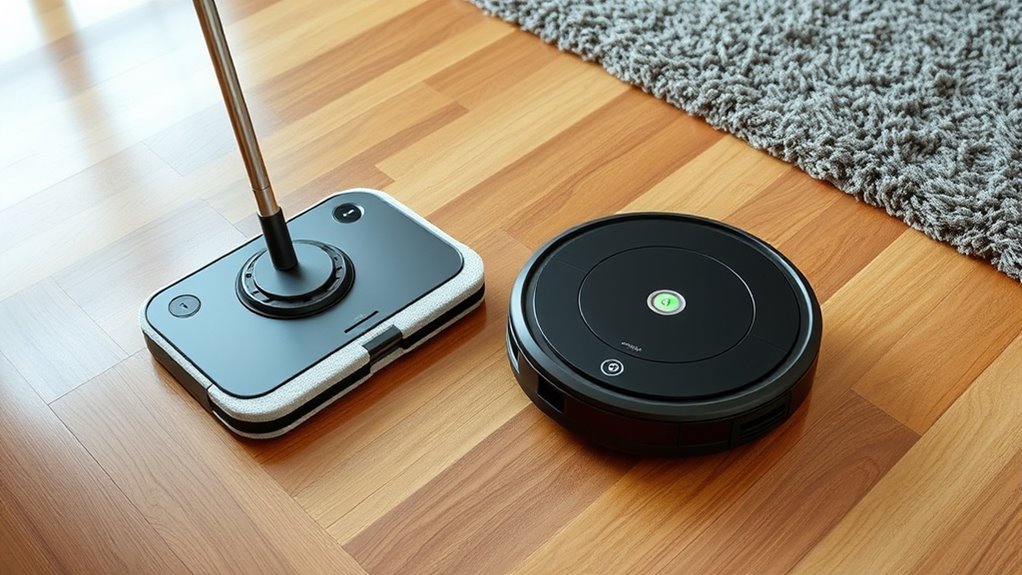
Robot vacuums are best suited for cleaning carpets and hard floors, especially in high-traffic areas where they can quickly pick up large debris, pet hair, and dirt. They excel at vacuuming tasks on surfaces like:
Robot vacuums excel at cleaning carpets and hard floors in busy areas, swiftly removing debris, pet hair, and dirt.
- Thick carpets with deep fibers
- Smooth hardwood or tile floors
- Rugs prone to trapping pet hair
- Areas needing routine dirt removal
They’re ideal for daily cleaning of high-traffic zones, quickly tackling surface-level dust and debris. Robot mops, on the other hand, are better for regular maintenance on hard floors, handling dust, light stains, and routine wet cleaning. They’re ineffective on carpets and rugs, which require stronger suction or manual deep cleaning. Hybrid models can manage mixed surfaces but may have limitations on deep cleaning and carpet handling.
Frequency and Routine Maintenance Considerations

To maintain a consistently clean floor, you need to schedule routine maintenance based on your household’s needs. The frequency of use depends on factors like pets and traffic. For surface upkeep, robot vacuums might run daily or weekly, while robot mops should be scheduled every 2-3 days for light dust and stains. Proper scheduling prevents buildup and reduces the need for deep cleaning. Use the following guide to plan your routine:
| Task | Frequency | Best for |
|---|---|---|
| Surface dust removal | Every 2-3 days | Robot mops |
| Regular cleaning | Daily/weekly | Robot vacuums |
| Deep cleaning | Periodically (manual) | Manual intervention |
| Stain removal | As needed | Spot treatments |
| Surface upkeep | Consistent scheduling | Overall floor maintenance |
Cost-Effectiveness and Long-Term Usage Benefits

While regular maintenance routines keep your floors looking their best, considering the long-term costs of cleaning devices helps you make smarter choices. Robot vacuums are generally more affordable upfront and excel at daily debris removal, making them a cost-effective choice for regular maintenance. Robot mops have higher initial costs due to advanced smart features like vibration mopping and auto-empty bases, but offer long-term savings through automation. Over time, self-emptying stations reduce maintenance and supply expenses, while versatile combo models minimize the need for extra tools. Imagine:
- A sleek device quietly working in the background
- Smart features scheduling cleanings around your day
- Extended intervals between manual emptying
- Consistent, effortless floor cleanliness
Choosing between these options depends on your budget and cleaning priorities for long-term savings.
Limitations and Challenges to Keep in Mind

Despite their convenience, robotic mops face several limitations that can impact their effectiveness. One major limitation is their cleaning capacity; small water tanks mean you’ll need frequent refills, especially for large or heavily soiled areas. Maintenance can also be challenging, particularly with complex or oscillating pads that require regular upkeep. Navigation remains a concern, as many models struggle with complex layouts or multiple floor types, risking water damage or incomplete cleaning. Additionally, most robotic mops lack scrubbing action, reducing their ability to tackle stubborn stains or sticky debris. These limitations mean you might need to supplement a robotic mop with manual cleaning or consider higher-end models with better navigation and larger water tanks to maximize efficiency.
Making the Right Decision Based on Your Lifestyle and Needs
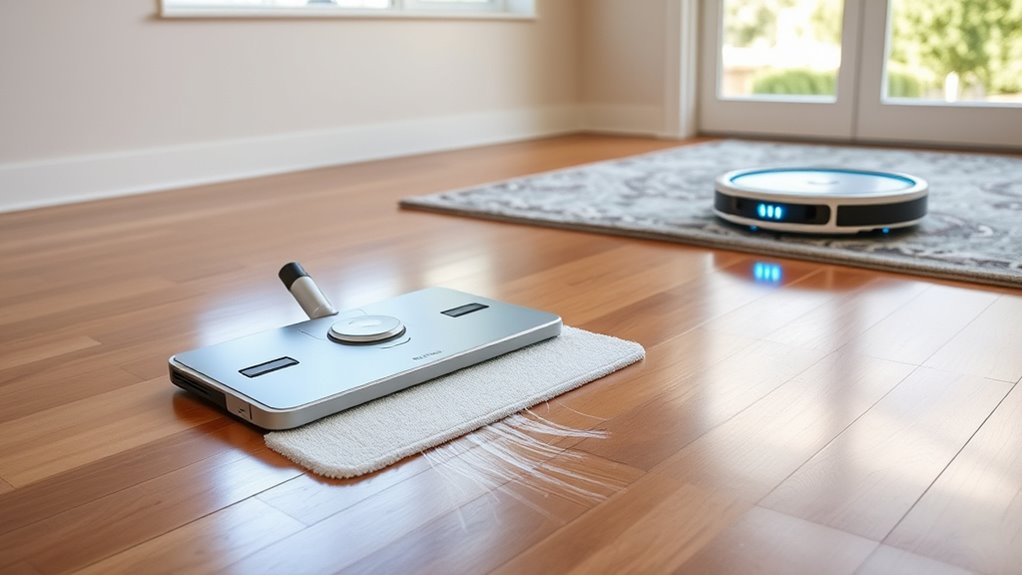
Choosing the right robotic cleaning device depends heavily on your lifestyle and specific needs. If you have carpets, pets, or high-traffic areas, a robot vacuum is ideal for deep cleaning heavy debris and maintaining floors. If your focus is light, regular cleaning on hard floors, a robot mop simplifies reaching under furniture and tight spots with minimal effort. Consider hybrid models if you need both functions, but expect higher costs and complexity.
Imagine these scenarios:
- Tackling pet hair and dirt on thick carpets
- Maintaining shiny hardwood floors effortlessly
- Cleaning under furniture without hassle
- Simplifying daily maintenance with automation
Match your floors and layout to your routine: robot vacuums excel on carpets and uneven surfaces, while robot mops work best on hard, consistent floors. Your lifestyle will guide your choice for ideal cleaning.
Frequently Asked Questions
Do Robot Vacuum and Mop Combos Work?
You wonder if robot vacuum and mop combos work. They do a good job for daily light cleaning by switching seamlessly between vacuuming and mopping modes thanks to smart sensors and mapping. However, they might struggle with deep stains or heavy dirt. For regular upkeep on sealed floors, they’re convenient and effective, but for tougher messes, you might still need dedicated vacuums or mops for a thorough clean.
How Often Should I Run My Robot Mop?
You should run your robot mop every 2-3 days for regular maintenance, especially if you have pets or kids. In high-traffic areas, consider mopping daily or every other day to keep floors hygienic. If your home is small to medium-sized with a 300-500 ml water tank, this schedule works well. For spills or deep cleaning, supplement with manual mopping or extra sessions as needed.
When Should I Run My Robot Vacuum?
You might think running your vacuum daily is overkill, but it actually prevents dust, pet hair, and debris buildup. You should run it several times a week, or even daily if needed. Schedule cleanings during your off-hours to minimize noise. Use higher suction for carpets or heavy dirt, and activate spot cleaning for messes. Remember to empty the dustbin regularly to keep performance ideal and maintain a clean, healthy home.
Which Robot Vacuums and Mops at the Same Time?
You want a robot that mops and vacuums simultaneously, so look for models like the Roborock S7 or DEEBOT X5 PRO OMNI. These advanced units can switch between vacuuming and mopping effortlessly, often doing both at once. Make sure they support mapping and zone control, so you can clean different areas efficiently without manual intervention. This way, you save time and keep your floors spotless with minimal effort.
Conclusion
Ultimately, choosing between a robot mop and vacuum depends on your lifestyle and needs. If you want a quick fix, a robot vacuum often does the trick. For deeper, wet cleaning, a robot mop shines. Remember, “A stitch in time saves nine.” Investing in the right device or combining both can keep your floors spotless with less effort. Make a smart choice today for a cleaner, more effortless home tomorrow.
